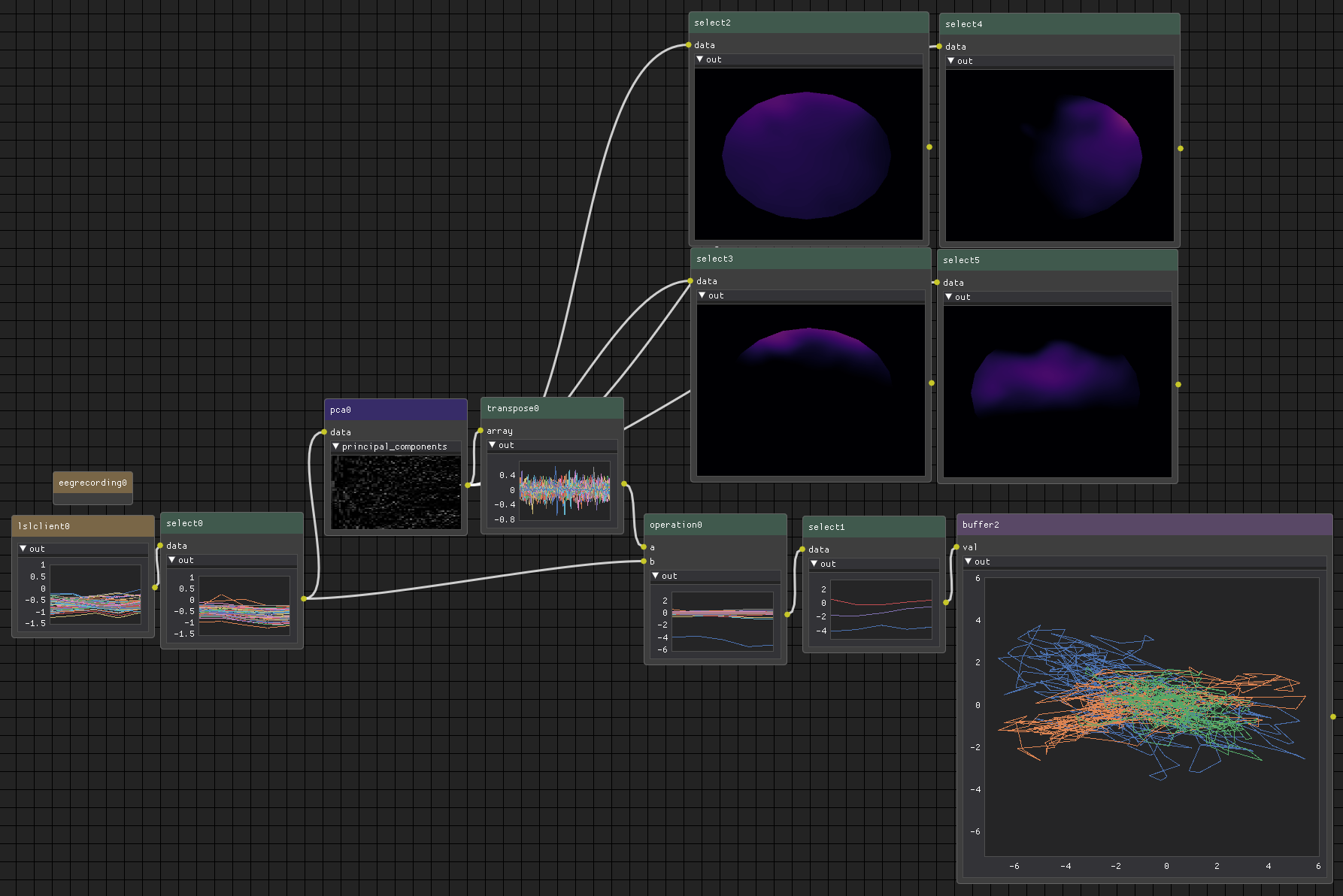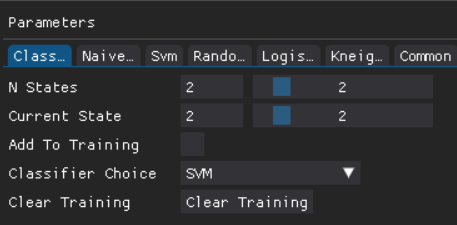Real-time neuro-/biosignal processing and streaming pipeline.
Project description

goofi-pipe
Generative Organic Oscillation Feedback Isomorphism Pipeline
Installation
If you only want to run goofi-pipe and not edit any of the code, make sure you activated the desired Python environment with Python>=3.9 and run the following commands in your terminal:
pip install goofi # install goofi-pipe
goofi-pipe # start the application
[!NOTE] On some platforms (specifically Linux and Mac) it might be necessary to install the
liblslpackage for some of goofi-pipe's features (everything related to LSL streams). Follow the instructions provided here, or simply install it viaconda install -c conda-forge liblsl
Development
Follow these steps if you want to adapt the code of existing nodes, or create custom new nodes. In your terminal, make sure you activated the desired Python environment with Python>=3.9, and that you are in the directory where you want to install goofi-pipe. Then, run the following commands:
git clone git@github.com:PhilippThoelke/goofi-pipe.git # download the repository
cd goofi-pipe # navigate into the repository
pip install -e . # install goofi-pipe in development mode
goofi-pipe # start the application to make sure the installation was successful
Basic Usage
Accessing the Node Menu
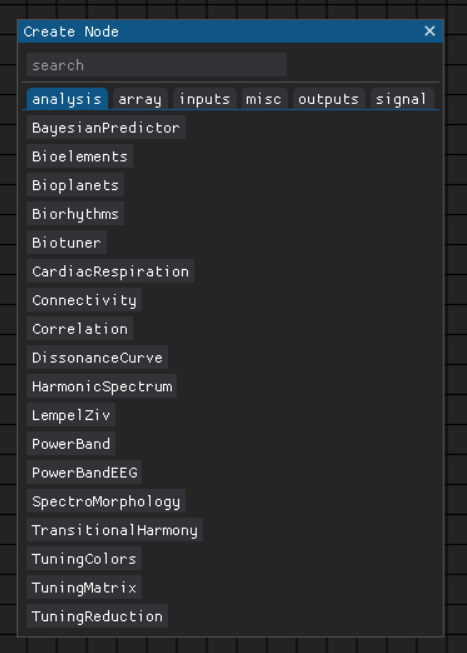
To access the node menu, simply double-click anywhere within the application window or press the 'Tab' key. The node menu allows you to add various functionalities to your pipeline. Nodes are categorized for easy access, but if you're looking for something specific, the search bar at the top is a handy tool.
Common Parameters and Metadata

Common Parameters: All nodes within goofi have a set of common parameters. These settings consistently dictate how the node operates within the pipeline.
-
AutoTrigger: This option, when enabled, allows the node to be triggered automatically. When disabled, the node is triggered when it receives input.
-
Max_Frequency: This denotes the maximum rate at which computations are set for the node.
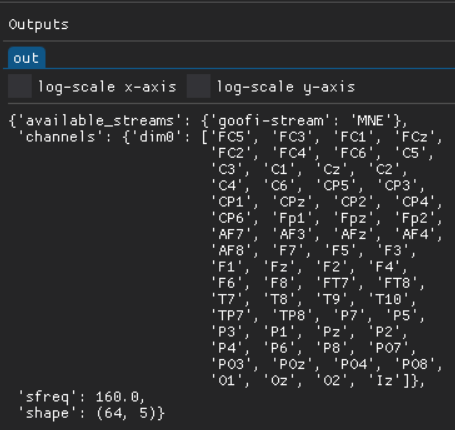
Metadata: This section conveys essential information passed between nodes. Each output node will be accompanied by its metadata, providing clarity and consistency throughout the workflow.
Here are some conventional components present in the metadata
-
Channel Dictionary: A conventional representation of EEG channels names.
-
Sampling Frequency: The rate at which data samples are measured. It's crucial for maintaining consistent data input and output across various nodes.
-
Shape of the Output: Details the format and structure of the node's output.
Playing with Pre-recorded EEG Signal using LslStream
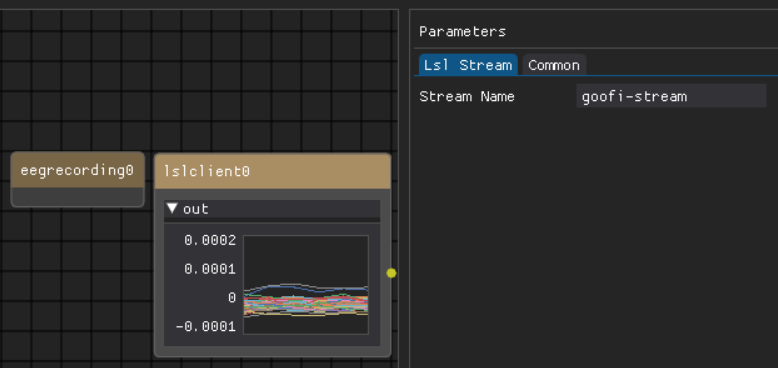
This image showcases the process of utilizing a pre-recorded EEG signal through the LslStream node. It's crucial to ensure that the Stream Name in the LslStream node matches the stream name in the node receiving the data. This ensures data integrity and accurate signal processing in real-time.
Patch examples
Basic Signal Processing Patch
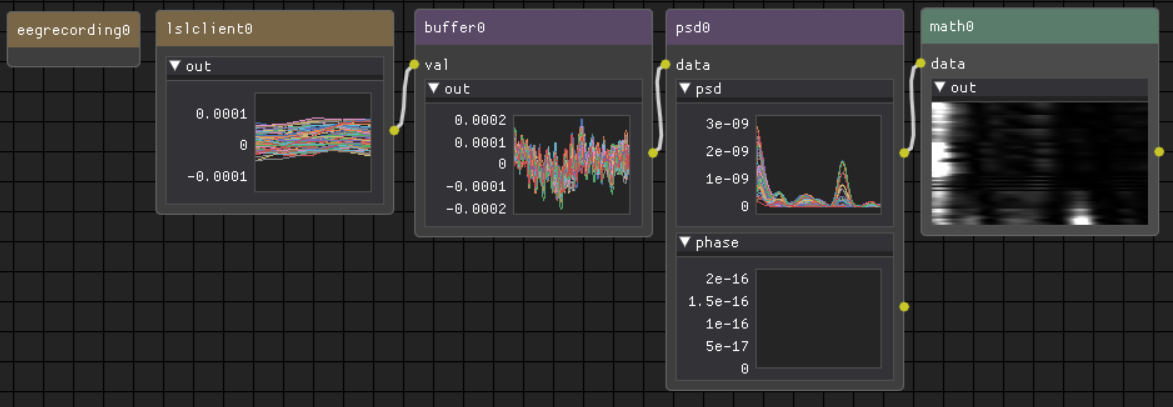
This patch provides a demonstration of basic EEG signal processing using goofi-pipe.
-
EegRecording: This is the starting point where the EEG data originates.
-
LslClient: The
LslClientnode retrieves the EEG data fromEegRecording. Here, the visual representation of the EEG data being streamed in real-time is depicted. By default, the multiple lines in the plot correspond to the different EEG channels. -
Buffer: This node holds the buffered EEG data.
-
Psd: Power Spectral Density (PSD) is a technique to measure a signal's power content versus frequency. In this node, the raw EEG data is transformed to exhibit its power distribution across distinct frequency bands.
-
Math: This node is employed to execute mathematical operations on the data. In this context, it's rescaling the values to ensure a harmonious dynamic range between 0 and 1, which is ideal for image representation. The resultant data is then visualized as an image.
One of the user-friendly features of goofi-pipe is the capability to toggle between different visualizations. By 'Ctrl+clicking' on any plot within a node, you can effortlessly switch between a line plot and an image representation, offering flexibility in data analysis.
Sending Power Bands via Open Sound Control (OSC)

Expanding on the basic patch, the advanced additions include:
- Select: Chooses specific EEG channels.
- PowerBandEEG: Computes EEG signal power across various frequency bands.
- ExtendedTable: Prepares data for transmission in a structured format.
- OscOut: Sends data using the Open-Sound-Control (OSC) protocol.
These nodes elevate data processing and communication capabilities.
Real-Time Connectivity and Spectrogram
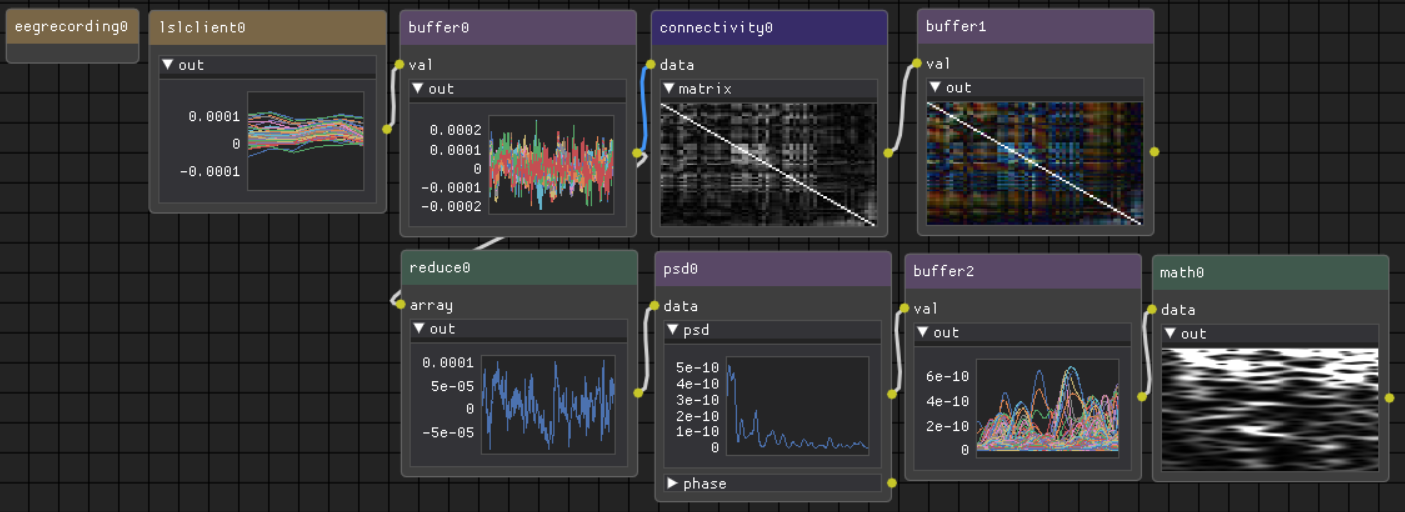
This patch highlights:
-
Connectivity: Analyzes relationships between EEG channels, offering selectable methods like
wPLI,coherence,PLI, and more. -
Spectrogram: Created using the
PSDnode followed by aBuffer, it provides a time-resolved view of the EEG signal's frequency content.
Principal Component Analysis (PCA)
Using PCA (Principal Component Analysis) allows us to reduce the dimensionality of raw EEG data, while retaining most of the variance. We use the first three components and visualize their trajectory, allowing us to identify patterns in the data over time. The topographical maps show the contrbution of each channel to the first four principal components (PCs).
Realtime Classification
leverage the multimodal framework of goofi, state-of-the-art machine learning classifiers can be built on-the-fly to predict behavior from an array of different sources. Here's a brief walkthrough of three distinct examples:
1. EEG Signal Classification

EEGrecording and LslStreammodule. The classifier module allows
to capture data from different states indicated by the user from n features, which in the present case are the 64 EEG channels. Some classifiers allow for visualization of feature importance. Here we show a topomap of the distribution of features importances on the scalp. The classifier outputs probability of being in each of the states in the training data. This prediction is smoothed using a buffer for less jiterry results.
2. Audio Input Classification
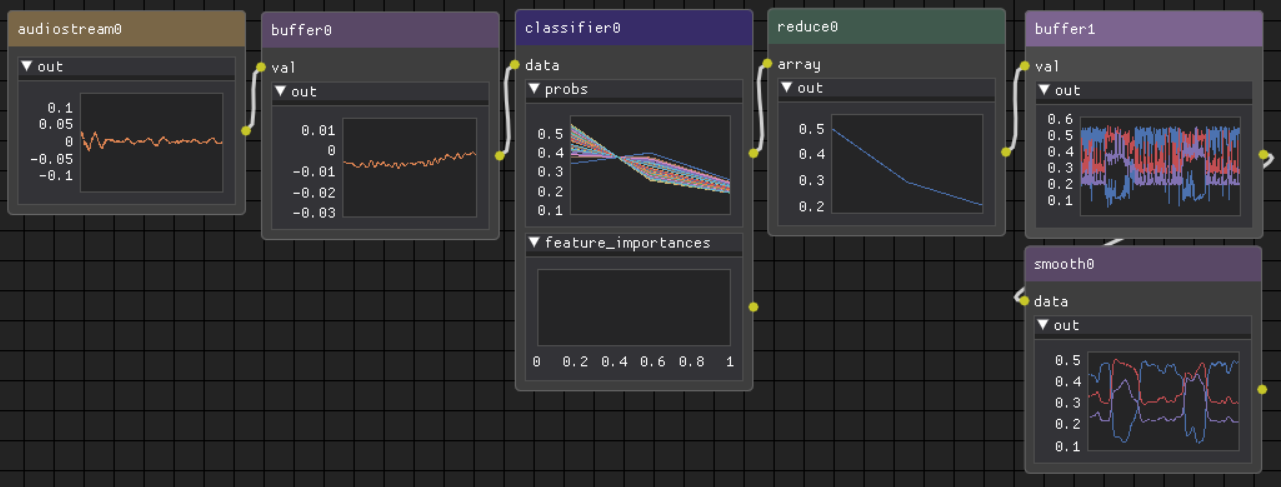
3. Video Input Classification

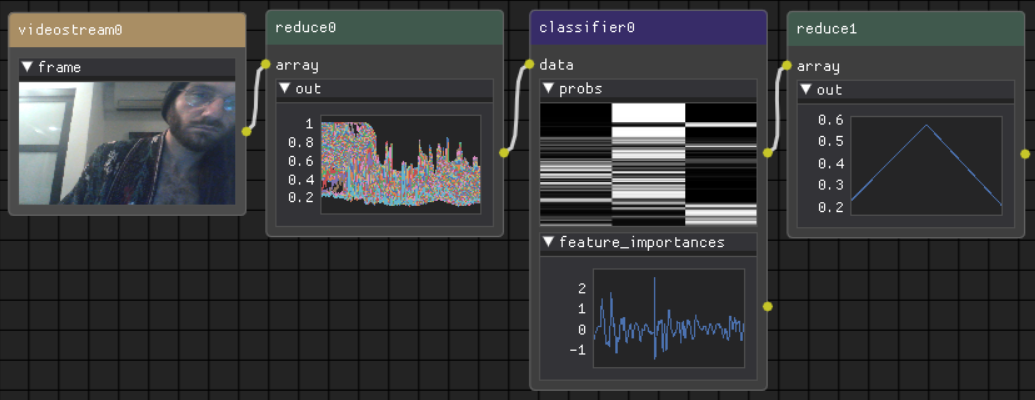
VideoStream module. Similarly, prediction of labelled visual states can be achieved in realtime.
The images show how two states (being on the left or the right side of the image) can be detected using classification
These patches demonstrate the versatility of our framework in handling various types of real-time data streams for classification tasks.
Musical Features using Biotuner
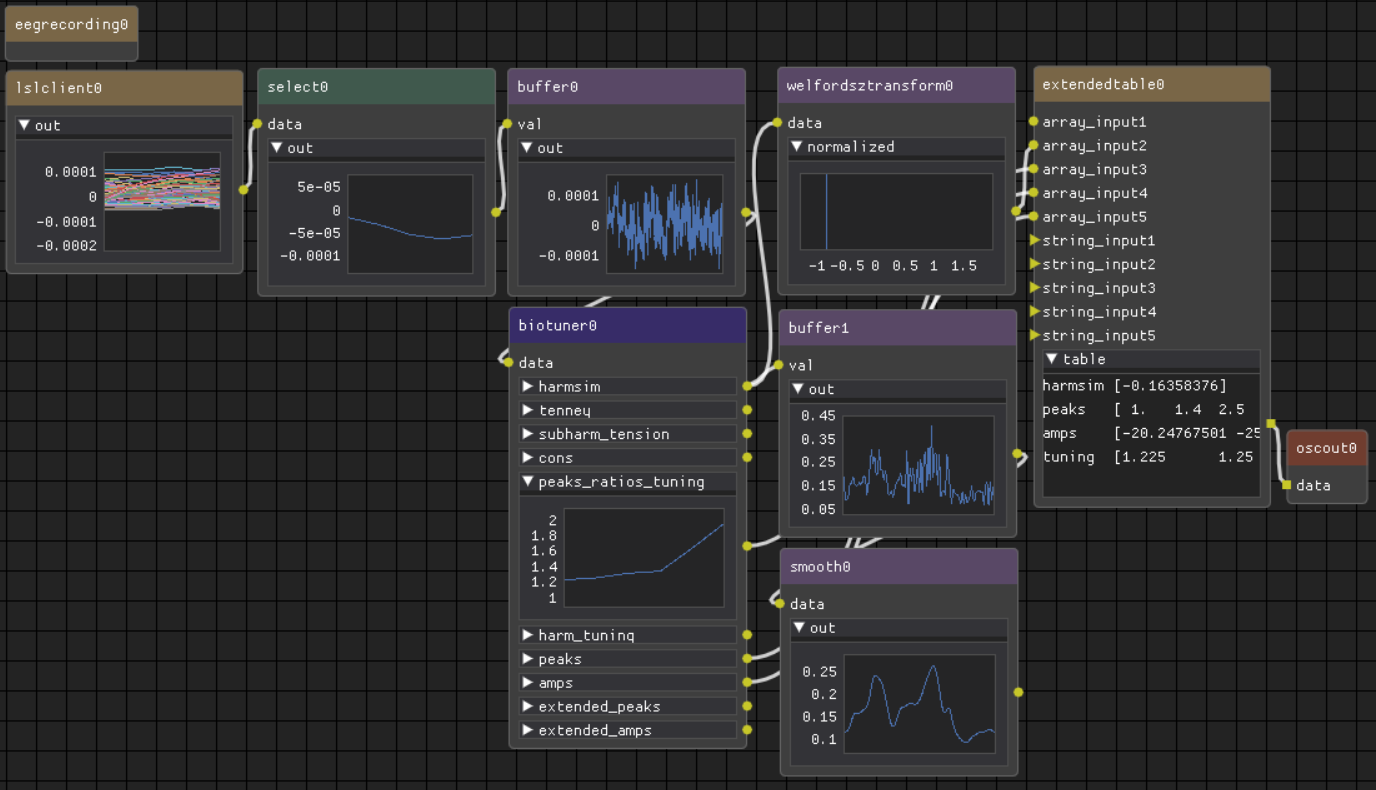
This patch presents a pipeline for processing EEG data to extract musical features:
-
Data flows from the EEG recording through several preprocessing nodes and culminates in the Biotuner node, which specializes in deriving musical attributes from the EEG.
-
Biotuner Node: With its sophisticated algorithms, Biotuner pinpoints harmonic relationships, tension, peaks, and more, essential for music theory analysis.
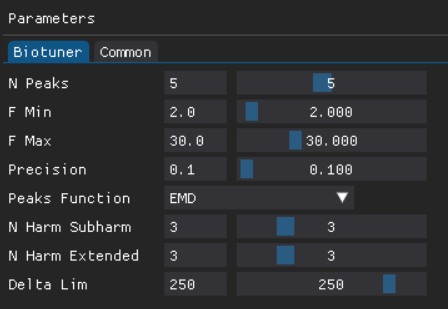
Delving into the parameters of the Biotuner node:
N Peaks: The number of spectral peaks to consider.F Min&F Max: Defines the frequency range for analysis.Precision: Sets the precision in Hz for peak extraction.Peaks Function: Method to compute the peaks, like EMD, fixed band, or harmonic recurrence.N Harm Subharm&N Harm Extended: Configures number of harmonics used in different computations.Delta Lim: Defines the maximal distance between two subharmonics to include in subharmonic tension computation.
For a deeper understanding and advanced configurations, consult the Biotuner repository.
Data Types
To simplify understanding, we've associated specific shapes with data types at the inputs and outputs of nodes:
- Circles: Represent arrays.
- Triangles: Represent strings.
- Squares: Represent tables.
Node Categories
Analysis
Nodes that perform analysis on the data.
View Nodes
AudioTagging
- Inputs:
- audioIn: ARRAY
- Outputs:
- tags: STRING
- probabilities: ARRAY
- embedding: ARRAY
Avalanches
- Inputs:
- data: ARRAY
- Outputs:
- size: ARRAY
- duration: ARRAY
Binarize
- Inputs:
- data: ARRAY
- Outputs:
- bin_data: ARRAY
Bioelements
- Inputs:
- data: ARRAY
- Outputs:
- elements: TABLE
Bioplanets
- Inputs:
- peaks: ARRAY
- Outputs:
- planets: TABLE
- top_planets: STRING
Biorhythms
- Inputs:
- tuning: ARRAY
- Outputs:
- pulses: ARRAY
- steps: ARRAY
- offsets: ARRAY
Biotuner
- Inputs:
- data: ARRAY
- Outputs:
- harmsim: ARRAY
- tenney: ARRAY
- subharm_tension: ARRAY
- cons: ARRAY
- peaks_ratios_tuning: ARRAY
- harm_tuning: ARRAY
- peaks: ARRAY
- amps: ARRAY
- extended_peaks: ARRAY
- extended_amps: ARRAY
CardiacRespiration
- Inputs:
- data: ARRAY
- Outputs:
- cardiac: ARRAY
CardioRespiratoryVariability
- Inputs:
- data: ARRAY
- Outputs:
- MeanNN: ARRAY
- SDNN: ARRAY
- SDSD: ARRAY
- RMSSD: ARRAY
- pNN50: ARRAY
- LF: ARRAY
- HF: ARRAY
- LF/HF: ARRAY
- LZC: ARRAY
Classifier
- Inputs:
- data: ARRAY
- Outputs:
- probs: ARRAY
- feature_importances: ARRAY
Clustering
- Inputs:
- matrix: ARRAY
- Outputs:
- cluster_labels: ARRAY
- cluster_centers: ARRAY
Compass
- Inputs:
- north: ARRAY
- south: ARRAY
- east: ARRAY
- west: ARRAY
- Outputs:
- angle: ARRAY
Connectivity
- Inputs:
- data: ARRAY
- Outputs:
- matrix: ARRAY
Coord2loc
- Inputs:
- latitude: ARRAY
- longitude: ARRAY
- Outputs:
- coord_info: TABLE
Correlation
- Inputs:
- data1: ARRAY
- data2: ARRAY
- Outputs:
- pearson: ARRAY
DissonanceCurve
- Inputs:
- peaks: ARRAY
- amps: ARRAY
- Outputs:
- dissonance_curve: ARRAY
- tuning: ARRAY
- avg_dissonance: ARRAY
EigenDecomposition
- Inputs:
- matrix: ARRAY
- Outputs:
- eigenvalues: ARRAY
- eigenvectors: ARRAY
ERP
- Inputs:
- signal: ARRAY
- trigger: ARRAY
- Outputs:
- erp: ARRAY
FacialExpression
- Inputs:
- image: ARRAY
- Outputs:
- emotion_probabilities: ARRAY
- action_units: ARRAY
- main_emotion: STRING
Fractality
- Inputs:
- data_input: ARRAY
- Outputs:
- fractal_dimension: ARRAY
GraphMetrics
- Inputs:
- matrix: ARRAY
- Outputs:
- clustering_coefficient: ARRAY
- characteristic_path_length: ARRAY
- betweenness_centrality: ARRAY
- degree_centrality: ARRAY
- assortativity: ARRAY
- transitivity: ARRAY
HarmonicSpectrum
- Inputs:
- psd: ARRAY
- Outputs:
- harmonic_spectrum: ARRAY
- max_harmonicity: ARRAY
- avg_harmonicity: ARRAY
Img2Txt
- Inputs:
- image: ARRAY
- Outputs:
- generated_text: STRING
LempelZiv
- Inputs:
- data: ARRAY
- Outputs:
- lzc: ARRAY
PCA
- Inputs:
- data: ARRAY
- Outputs:
- principal_components: ARRAY
PoseEstimation
- Inputs:
- image: ARRAY
- Outputs:
- pose: ARRAY
PowerBand
- Inputs:
- data: ARRAY
- Outputs:
- power: ARRAY
PowerBandEEG
- Inputs:
- data: ARRAY
- Outputs:
- delta: ARRAY
- theta: ARRAY
- alpha: ARRAY
- lowbeta: ARRAY
- highbeta: ARRAY
- gamma: ARRAY
ProbabilityMatrix
- Inputs:
- input_data: ARRAY
- Outputs:
- data: ARRAY
SpectroMorphology
- Inputs:
- data: ARRAY
- Outputs:
- spectro: ARRAY
SpeechSynthesis
- Inputs:
- text: STRING
- voice: ARRAY
- Outputs:
- speech: ARRAY
- transcript: STRING
TransitionalHarmony
- Inputs:
- data: ARRAY
- Outputs:
- trans_harm: ARRAY
- melody: ARRAY
TuningColors
- Inputs:
- data: ARRAY
- Outputs:
- hue: ARRAY
- saturation: ARRAY
- value: ARRAY
- color_names: STRING
TuningMatrix
- Inputs:
- tuning: ARRAY
- Outputs:
- matrix: ARRAY
- metric_per_step: ARRAY
- metric: ARRAY
TuningReduction
- Inputs:
- tuning: ARRAY
- Outputs:
- reduced: ARRAY
VAMP
- Inputs:
- data: ARRAY
- Outputs:
- comps: ARRAY
VocalExpression
- Inputs:
- data: ARRAY
- Outputs:
- prosody_label: STRING
- burst_label: STRING
- prosody_score: ARRAY
- burst_score: ARRAY
Array
Nodes implementing array operations.
View Nodes
Clip
- Inputs:
- array: ARRAY
- Outputs:
- out: ARRAY
Join
- Inputs:
- a: ARRAY
- b: ARRAY
- Outputs:
- out: ARRAY
Math
- Inputs:
- data: ARRAY
- Outputs:
- out: ARRAY
Operation
- Inputs:
- a: ARRAY
- b: ARRAY
- Outputs:
- out: ARRAY
Reduce
- Inputs:
- array: ARRAY
- Outputs:
- out: ARRAY
Reshape
- Inputs:
- array: ARRAY
- Outputs:
- out: ARRAY
Select
- Inputs:
- data: ARRAY
- Outputs:
- out: ARRAY
Transpose
- Inputs:
- array: ARRAY
- Outputs:
- out: ARRAY
Inputs
Nodes that provide data to the pipeline.
View Nodes
Audiocraft
- Inputs:
- prompt: STRING
- Outputs:
- wav: ARRAY
AudioStream
- Inputs:
- Outputs:
- out: ARRAY
ConstantArray
- Inputs:
- Outputs:
- out: ARRAY
ConstantString
- Inputs:
- Outputs:
- out: STRING
EEGRecording
- Inputs:
- Outputs:
ExtendedTable
- Inputs:
- base: TABLE
- array_input1: ARRAY
- array_input2: ARRAY
- array_input3: ARRAY
- array_input4: ARRAY
- array_input5: ARRAY
- string_input1: STRING
- string_input2: STRING
- string_input3: STRING
- string_input4: STRING
- string_input5: STRING
- Outputs:
- table: TABLE
FractalImage
- Inputs:
- complexity: ARRAY
- Outputs:
- image: ARRAY
ImageGeneration
- Inputs:
- prompt: STRING
- negative_prompt: STRING
- base_image: ARRAY
- Outputs:
- img: ARRAY
Kuramoto
- Inputs:
- initial_phases: ARRAY
- Outputs:
- phases: ARRAY
- coupling: ARRAY
- order_parameter: ARRAY
- waveforms: ARRAY
LoadFile
- Inputs:
- Outputs:
- data_output: ARRAY
LSLClient
- Inputs:
- Outputs:
- out: ARRAY
MeteoMedia
- Inputs:
- latitude: ARRAY
- longitude: ARRAY
- location_name: STRING
- Outputs:
- weather_data_table: TABLE
OSCIn
- Inputs:
- Outputs:
- message: TABLE
PromptBook
- Inputs:
- input_prompt: STRING
- Outputs:
- out: STRING
Reservoir
- Inputs:
- connectivity: ARRAY
- Outputs:
- data: ARRAY
SerialStream
- Inputs:
- Outputs:
- out: ARRAY
Sine
- Inputs:
- Outputs:
- out: ARRAY
Table
- Inputs:
- base: TABLE
- new_entry: ARRAY
- Outputs:
- table: TABLE
TextGeneration
- Inputs:
- prompt: STRING
- Outputs:
- generated_text: STRING
VideoStream
- Inputs:
- Outputs:
- frame: ARRAY
ZeroMQIn
- Inputs:
- Outputs:
- data: ARRAY
Misc
Miscellaneous nodes that do not fit into other categories.
View Nodes
AppendTables
- Inputs:
- table1: TABLE
- table2: TABLE
- Outputs:
- output_table: TABLE
ColorEnhancer
- Inputs:
- image: ARRAY
- Outputs:
- enhanced_image: ARRAY
EdgeDetector
- Inputs:
- image: ARRAY
- Outputs:
- edges: ARRAY
FormatString
- Inputs:
- input_string_1: STRING
- input_string_2: STRING
- input_string_3: STRING
- input_string_4: STRING
- input_string_5: STRING
- input_string_6: STRING
- input_string_7: STRING
- input_string_8: STRING
- input_string_9: STRING
- input_string_10: STRING
- Outputs:
- output_string: STRING
HSVtoRGB
- Inputs:
- hsv_image: ARRAY
- Outputs:
- rgb_image: ARRAY
JoinString
- Inputs:
- string1: STRING
- string2: STRING
- string3: STRING
- string4: STRING
- string5: STRING
- Outputs:
- output: STRING
RGBtoHSV
- Inputs:
- rgb_image: ARRAY
- Outputs:
- hsv_image: ARRAY
SetMeta
- Inputs:
- array: ARRAY
- Outputs:
- out: ARRAY
StringAwait
- Inputs:
- message: STRING
- trigger: ARRAY
- Outputs:
- out: STRING
TableSelectArray
- Inputs:
- input_table: TABLE
- Outputs:
- output_array: ARRAY
TableSelectString
- Inputs:
- input_table: TABLE
- Outputs:
- output_string: STRING
Outputs
Nodes that send data to external systems.
View Nodes
AudioOut
- Inputs:
- data: ARRAY
- Outputs:
- finished: ARRAY
LSLOut
- Inputs:
- data: ARRAY
- Outputs:
MidiCCout
- Inputs:
- cc1: ARRAY
- cc2: ARRAY
- cc3: ARRAY
- cc4: ARRAY
- cc5: ARRAY
- Outputs:
- midi_status: STRING
MidiOut
- Inputs:
- note: ARRAY
- velocity: ARRAY
- duration: ARRAY
- Outputs:
- midi_status: STRING
OSCOut
- Inputs:
- data: TABLE
- Outputs:
SharedMemOut
- Inputs:
- data: ARRAY
- Outputs:
WriteCsv
- Inputs:
- table_input: TABLE
- Outputs:
ZeroMQOut
- Inputs:
- data: ARRAY
- Outputs:
Signal
Nodes implementing signal processing operations.
View Nodes
Buffer
- Inputs:
- val: ARRAY
- Outputs:
- out: ARRAY
Cycle
- Inputs:
- signal: ARRAY
- Outputs:
- cycle: ARRAY
EMD
- Inputs:
- data: ARRAY
- Outputs:
- IMFs: ARRAY
FFT
- Inputs:
- data: ARRAY
- Outputs:
- mag: ARRAY
- phase: ARRAY
Filter
- Inputs:
- data: ARRAY
- Outputs:
- filtered_data: ARRAY
FOOOFaperiodic
- Inputs:
- psd_data: ARRAY
- Outputs:
- offset: ARRAY
- exponent: ARRAY
- cf_peaks: ARRAY
- cleaned_psd: ARRAY
FrequencyShift
- Inputs:
- data: ARRAY
- Outputs:
- out: ARRAY
Hilbert
- Inputs:
- data: ARRAY
- Outputs:
- inst_amplitude: ARRAY
- inst_phase: ARRAY
- inst_frequency: ARRAY
IFFT
- Inputs:
- spectrum: ARRAY
- phase: ARRAY
- Outputs:
- reconstructed: ARRAY
PSD
- Inputs:
- data: ARRAY
- Outputs:
- psd: ARRAY
Recurrence
- Inputs:
- input_array: ARRAY
- Outputs:
- recurrence_matrix: ARRAY
- RR: ARRAY
- DET: ARRAY
- LAM: ARRAY
Resample
- Inputs:
- data: ARRAY
- Outputs:
- out: ARRAY
ResampleJoint
- Inputs:
- data1: ARRAY
- data2: ARRAY
- Outputs:
- out1: ARRAY
- out2: ARRAY
Smooth
- Inputs:
- data: ARRAY
- Outputs:
- out: ARRAY
StaticBaseline
- Inputs:
- data: ARRAY
- Outputs:
- normalized: ARRAY
Threshold
- Inputs:
- data: ARRAY
- Outputs:
- thresholded: ARRAY
TimeDelayEmbedding
- Inputs:
- input_array: ARRAY
- Outputs:
- embedded_array: ARRAY
WelfordsZTransform
- Inputs:
- data: ARRAY
- Outputs:
- normalized: ARRAY
Project details
Download files
Download the file for your platform. If you're not sure which to choose, learn more about installing packages.
Source Distribution
Built Distribution
File details
Details for the file goofi-2.1.6.tar.gz.
File metadata
- Download URL: goofi-2.1.6.tar.gz
- Upload date:
- Size: 469.6 kB
- Tags: Source
- Uploaded using Trusted Publishing? No
- Uploaded via: twine/5.1.1 CPython/3.9.20
File hashes
| Algorithm | Hash digest | |
|---|---|---|
| SHA256 | bee93f86a7828bf73e8045054e76c9d3a5b7034fceec7e231e741d235b7dd40d |
|
| MD5 | f14702e63cfd38d0608872b6a08dbdc3 |
|
| BLAKE2b-256 | 9db2ffa83a59acd3352ca42b39bae6822b4879ff5d334a8ae3305838cf4b0b0b |
File details
Details for the file goofi-2.1.6-py3-none-any.whl.
File metadata
- Download URL: goofi-2.1.6-py3-none-any.whl
- Upload date:
- Size: 509.7 kB
- Tags: Python 3
- Uploaded using Trusted Publishing? No
- Uploaded via: twine/5.1.1 CPython/3.9.20
File hashes
| Algorithm | Hash digest | |
|---|---|---|
| SHA256 | 3c59cdb4187e9fc328af4d1b8ecb9e622840d3bf5de1b886e8286c33c5310281 |
|
| MD5 | 68042f41a7799ac8bcfdf7dfe4a5dcf1 |
|
| BLAKE2b-256 | cea9dd629c9370c0eeaa61bea21a5d596622721d2a2338c130bd7710430233e6 |


